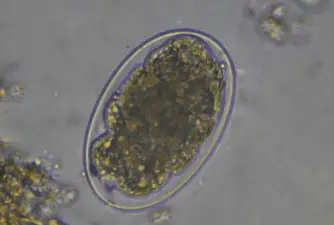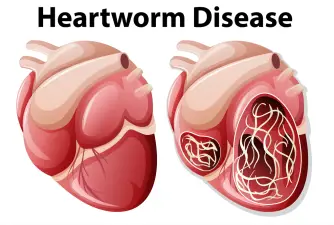Tapeworms in Dogs | Treatment & Signs
01.12.2021.
Unfortunately, our fateful furry companions can get infected with different parasites. This might not be very surprising since our dogs love sniffing the ground, other dogs’ or cats’ poop, animal carcasses, and other things that can get them in direct contact with parasitic eggs. However, one parasite has a different way of infecting dogs. Tapeworms need an intermediate host to infect dogs. If you’re worried about your dog’s health and you suspect they might have this parasite, here’s what you should know about tapeworms in dogs.
What are tapeworms?
Tapeworms are intestinal parasites that can infect dogs and cats. There are different types of tapeworms, but the most common one in dogs is the Dipylidium caninum. These worms are flat, segmented, and can reach 11 inches in length.
Tapeworm lifecycle
To fully understand these nasty parasites, we need to understand their lifecycle. Like many other parasites, the tapeworm will release its eggs into the environment by releasing a part of its body in the dog’s intestines. These eggs will get expelled when the dog defecates. The proglottids (part of its body) are filled with eggs, and it can be clearly seen in the dog’s feces. Eventually, the proglottids will dry up, break, and release the eggs into the environment.

After that process, a flea larva has to ingest the tapeworm egg. As the larva matures into an adult flea, the tapeworm egg will evolve as well. It will wait until the flea infects a host like a dog or a cat, and only then will it develop into an adult tapeworm. After it reaches the host’s intestines, the process can start all over again.
How can dogs get infected?
As you can see, tapeworm has a different way of infecting dogs. Most parasites will infect dogs through other animals’ feces. However, to get a tapeworm, the dog needs to ingest an adult tapeworm-infected flea. The three most common cases of tapeworm infections look like this;
- A dog gets fleas while playing with other flea-infested dogs. One or more fleas are infected with tapeworm, and dogs eat them.
- A dog can get infected with fleas if they play with flea-infested dogs and accidentally eats a flea while playing.
- A dog tries to eat an animal carcass that is infested with tapeworm-infested fleas.
VET TIP: It is crucial you teach your dog not to eat feces or animal carcasses. We know it might be difficult, but it is the best way to prevent them from getting infected with different parasites.
How do vets diagnose tapeworms in dogs?
The most common way of diagnosing tapeworms in dogs is by observing the proglottids in the dog’s stool sample. However, these tiny white or golden parts are not passed during every defecation. That means you might have to observe several of your dog’s stools. If you notice things like tiny white rice segments in your dog’s stool, you should take that sample and bring it to your vet.

In some cases, parts of the tapeworm can be seen moving around the dog’s anus. If you notice that, you should call your vet and ask for instructions. However, that is usually a clear sign of tapeworms in dogs.
In rare cases, the tapeworm can detach itself from the intestinal lining. If that happens, the infected dog can poop out the whole worm. If the parasite migrated to the dog’s stomach, the dog can vomit it. If that happens, you should take the sample and bring it to your vet.
VET TIP: One of the possible signs your dog has a tapeworm is scooting. Dogs can drag their rear end on the ground. You can read more about it here - Why is my dog dragging its butt?
How dangerous are tapeworms in dogs?
The good news about tapeworms is that they are not that dangerous. However, they need to be treated. If the dog is treated in time, they will be saved from significant health issues. If the owners fail to provide the necessary treatment, tapeworm infections can lead to growth issues, anemia, constipation, and blockage.
How is tapeworm infection treated?
Another great thing about tapeworms is that they are easily treatable. There are different antiparasitic medications you can give to your dog to get rid of this nasty parasite. These medications will cause the tapeworm to dissolve and get digested. In a way, instead of the tapeworm eating your dog, the dog will eat the tapeworm. If the treatment is successful, you should see the tapeworm in your dog’s stool. You can read more about these medications here - Best dog dewormers.

Can I get infected if my dog has tapeworms?
Humans cannot get directly infected by their dogs. The process of getting infected with tapeworms is the same for humans and dogs. That means you should eat a tapeworm-carrying flea. If your dog doesn’t have fleas, you are pretty sure you will not get infected with tapeworm. However, it is best to thoroughly clean your home if your dog has tapeworms.
There were some cases where children got infected with tapeworm. They played with dogs that had fleas, and due to poor hygiene (most lack of washing hands), got infected.
Can tapeworms be prevented?
Since tapeworms can only infect our dogs through fleas, the best way of preventing tapeworm infections is by preventing our dogs from getting infected with fleas. You should also prevent your dog from sniffing or eating animal carcasses that might have fleas. If you take preventive measures, there is a good chance your dog will be safe from tapeworms. You can do that by getting your dog flea and tick collars or medications like NexGard.
World Dog Finder team







Share